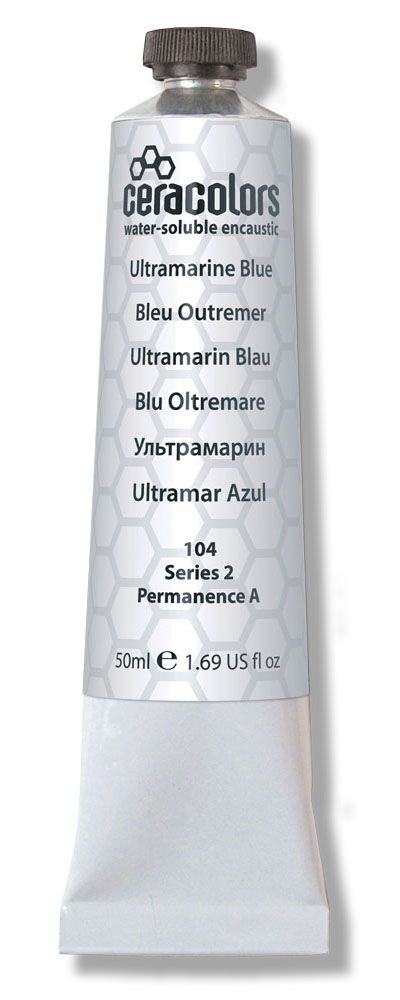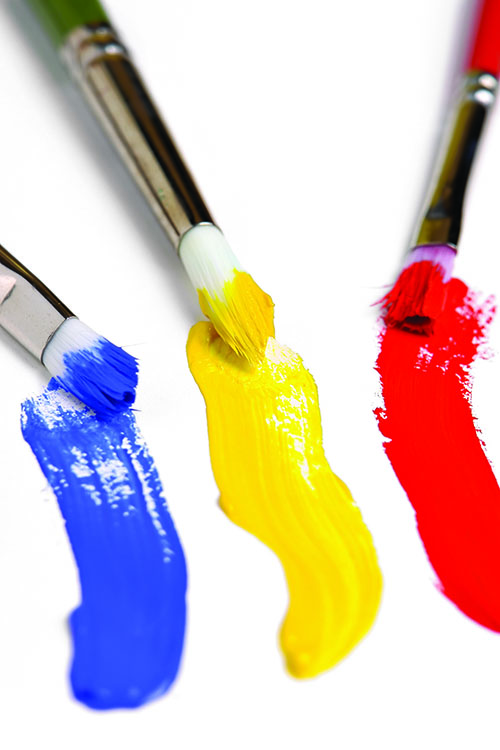Ceracolors: New Paint Medium of Water-Soluble Cold Wax

 It’s not often that a brand-new fine art medium comes along. Ceracolors is a new artist-grade paint made from quality pigments in a water-soluble wax binder. Although made from wax, Ceracolors are not encaustic paints because they do not require heat, solvents, or mediums. Ceracolors is a new cold wax paint medium.
It’s not often that a brand-new fine art medium comes along. Ceracolors is a new artist-grade paint made from quality pigments in a water-soluble wax binder. Although made from wax, Ceracolors are not encaustic paints because they do not require heat, solvents, or mediums. Ceracolors is a new cold wax paint medium.
Ceracolors share properties with traditional media that will make them instantly familiar to painters, but they also have unique characteristics and advantages. When thinned with water, Ceracolors easily disperse to produce vibrant watercolor effects. They can be applied in opaque layers, much like acrylic or gouache. Because the paints dry and set quickly, transparent glazes can be built up without long waiting times between layers. In a finished painting, the colors have a rich, matte appearance and a durable finish.
Ceracolors is water-soluble beeswax-based paint for professional artists providing a wide range of painting techniques from acrylic and gouache-like layers to thin watercolor-like washes. They are fast-drying colors suitable for all supports used for encaustic painting, yet they do not require special tools or heated instruments. Use any brush suitable for water-based paint. Once dry, Ceracolors can be used in the encaustic technique, allowing sculpting and manipulation of the paint. The ingredients in Ceracolors are found in food and cosmetics, so they are not considered toxic.
See the entire range of colors:
See mediums and additives:
Drying
Ceracolors dry in two stages. First, the paint dries rapidly due to the evaporation of water, so it is touch dry within a short time. After this initial period, the paint can be reopened with a wet brush. During the second stage, wax crystals coalesce as the paint cures. This can take from one to several days for thicker applications of paint.
Water Solubility
Ceracolors are thinned with water. The paint comes out of the tube as a paste and can be diluted to the consistency of watercolors. The water solubility of Ceracolors allows easy handling and cleaning.
Color and Appearance
Ceracolors are available in many colors that artists use in other professional-quality mediums. Ceracolors are formulated for high tinting strength, and the optical qualities of wax provide outstanding chroma.
Heat Setting
Uncured paint has limited wet scrub resistance, especially in thick layers. This resistance increases when the paint is set by heat. A heat gun or hair dryer can apply moderate heat.
Toxicity
Ceracolors are composed of ingredients not considered toxic—ingredients often found in food and cosmetics. There are no hazardous solvents or additives, and it does not require heating that can release potentially toxic fumes.
Supports
Rigid supports, such as wood, are best for cold wax and encaustic painting techniques, but flexible supports, such as canvas and paper, can also be used thinly as washes on absorbent grounds.
Hardness
Ceracolors are made with a blend of waxes microemulsified in water. Wax is soft with low scratch resistance, so works require care when handling and storing.
Durability
Water-soluble wax paint is durable, as attested by the present state of preservation of Roman and Roman-Egyptian paintings of the first century in many museums throughout the world.
Clean Up
Cleaning brushes and equipment is easy with soap and water. Cured Ceracolors paint can be removed with ammonia water.

What is Encaustic and Wax Painting?
Encaustic paint consists of wax and pigments. It is melted and applied as a liquid or paste to a surface—usually, wood, although canvas and other materials are used.
The most straightforward encaustic paint is made by adding pigments to beeswax, but many other recipes include other types of waxes, resins, linseed oil, or other ingredients.
Metal tools and special brushes are used to shape the paint before it cools, or heated metal tools can manipulate the wax once it has solidified.
The word “encaustic” originates from the Greek word enkaustikos, which means to “burn in,” and this element of heat is necessary for a painting to be called “encaustic.”
Brief History of Encaustic and Wax Painting
In his Natural History from the first century, the earliest description of wax and encaustic painting technique is by the Roman scholar Pliny, the Elder. This technique was used in the Fayum mummy portraits from Egypt around 100–300 CE and the sixth-century icon of Christ from Saint Catherine’s Monastery and other early icons.
Encaustic painting became outmoded at the end of the seventh century. Very few icons were painted in encaustic after the iconoclastic controversy began around 726.
About 1749, Comte de Caylus, a French antiquarian interested in Pliny’s writings on encaustic, began experimenting with the medium. He undertook to explain an obscure passage in Pliny regarding “Punic wax,” a water-soluble wax preparation believed to be the paint used by ancient Greek painters.
The Chevalier Lorgna, about 1787, investigated the making of Punic wax in a brief paper, Un Discurso sulla Cera Punica, where he asserts that the nitron Pliny mentions is the native salt found in the Wadi El Natrun valley of Egypt. Later in the eighteenth century, wax painting experiments were performed by the Italian painter Antonio Paccheri, who made Punic wax with water infused with gum arabic.
In 1792, the Society of Arts awarded Mrs. Hooker the gold palette for her experiments in painting with wax. It published her results in the tenth volume of the Society’s Transactions under Emma Jane Greenland. Not long after these investigations, encaustic paintings began to appear in England, Germany, Italy, and Sweden.
In the twentieth century, painter Fritz Faiss (1905–1981), a student of Paul Klee and Wassily Kandinsky at the Bauhaus, and Dr. Hans Schmid rediscovered the so-called “Punic wax” technique. The resulting wax is believed to be the same as the Punic wax described by Pliny. Encaustic painting is used in many works of twentieth-century artists, including Jasper Johns, Arthur Dove, Tony Scherman, and Mark Perlman.
Today, Ceracolors gives new life to wax painting by using the latest emulsification technology to create a water-soluble wax paint that may offer similar handling characteristics as the wax paint of the ancients, commonly referred to today as “Punic wax.”











